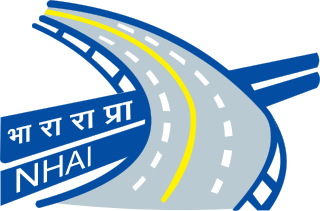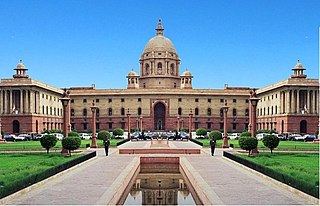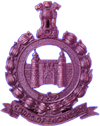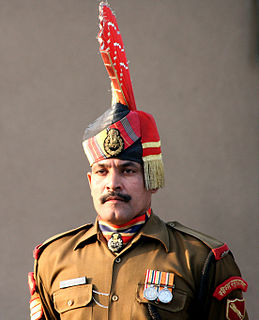
Kanpur( pronunciation ; formerlyCawnpore) is a large city in the state of Uttar Pradesh, India. The city is famous for its leather and textile industries. It is 11th most populous urban agglomeration in India and largest urban agglomeration in Uttar Pradesh. Kanpur was an important British garrison town until 1947 when India gained independence. Kanpur the administrative headquarter of Kanpur (Urban) district and Kanpur division.

The Indian Police Service or IPS, is an All India Service for policing. It replaced the Indian Imperial Police in 1948, a year after India became independent from Great Britain.

Law enforcement in India is performed by numerous law enforcement agencies. Like many federal nations, the nature of the Constitution of India mandates law and order as a responsibility of the state. Therefore the bulk of the policing lies with the respective states and territories of India.

|The National Highways network of India is a network of trunk roads that is owned by the Ministry of Road Transport and Highways. It is constructed and managed by the National Highway Authority of India (NHAI), the National Highways and Infrastructure Development Corporation (NHIDCL), and the public works departments (PWDs) of state governments. NHAI was established by the National Highways Authority of India Act, 1988. Section 16(1) of the Act states that the function of NHAI is to develop, maintain, and manage the National Highways and any other highways vested in, or entrusted to, it by the Government of India. These highways as of April 2019 measure over 142,126 km (88,313 mi). The Indian government has vowed to double the highway length from 96,000 to 2,00,000 km.
An inspector general is an investigative official in a civil or military organization. The plural of the term is "inspectors general".

The Border Roads Organisation (BRO) develops and maintains road networks in India's border areas and friendly neighboring countries. Officers from the Border Roads Engineering Service (BRES) and personnel from the General Reserve Engineer Force (GREF) form the parent cadre of the Border Roads Organisation. It is also staffed by officers and troops drawn from the Indian Army's Corps of Engineers on extra regimental employment. Currently, the organisation maintains operations in twenty-one states, one UT, and neighboring countries such as Afghanistan, Bhutan, Myanmar, and Sri Lanka. The BRO operates and maintains over 32,885 kilometers of roads and about 12,200 meters of permanent bridges in the country. Presently, BRO is also involved in the construction of a tunnel at the Rohtang pass which is estimated to be ready by 2019.
The All India Services (AIS) comprises Civil Services of India, namely the Indian Administrative Service (IAS), the Indian Forest Service (IFoS) and the Indian Police Service (IPS). A common unique feature of the All India Services is that the members of these services are recruited by the Centre, but their services are placed under various State cadres, and they have the liability to serve both under the State and under the Centre. Due to the federal polity of the country, this is considered one of the tools that makes union government stronger than state governments. Officers of these three services comply to the All India Services Rules relating to pay, conduct, leave, various allowances etc.

The National Highways Authority of India (NHAI) is an autonomous agency of the Government of India, set up in 1988 and is responsible for management of a network of over 50,000 km of National Highways out of 1,15,000 km in India. It is a nodal agency of the Ministry of Road Transport and Highways. NHAI has signed a memorandum of understanding (MoU) with the Indian Space Research Organisation for satellite mapping of highways. Nagendra Nath Sinha (IAS), is the present Chairman of NHAI since March 2019.

The Ministry of Home Affairs (MHA) or Home Ministry is a ministry of the Government of India. As the interior ministry of India, it is mainly responsible for the maintenance of internal security and domestic policy. The Home Ministry is headed by Union Minister of Home Affairs Rajnath Singh.

Kerala, southern most state of India has a network of 11 National Highways, 72 State Highways and many district roads.

The Corps of Engineers of the Indian Army has a long history dating back to the mid-18th century. The earliest existing subunit of the Corps dates back to 1777 while the Corps officially recognises its birth as 1780 when the senior most group of the Corps, the Madras Sappers were raised.

Gazetted officers include all the Indian Police Service officers which are Class I officers of the cadre and all State Police Services officers of and above the rank of inspector of police and State Police forces respectively. All are arranged in a hierarchical order.
The Sixth Central Pay Commission was convened by the Union Cabinet of India on 5 October 2006. The Pay Commission was headed by B. N. Srikrishna. The other members of the Commission were Ravindra Dholakia, J. S. Mathur, and Member-Secretary Sushama Nath.
The Ministry of Road Transport and Highways is a ministry of the Government of India, that is the apex body for formulation and administration of the rules, regulations and laws relating to road transport, transport research and in also to increase the mobility and efficiency of the road transport system in India. Through its officers of Central Engineering Services (Roads) cadre it is responsible for the development of National Highways of the country. Road transport is a critical infrastructure for economic development of the country. It influences the pace, structure and pattern of development. In India, roads are used to transport over 60 percent of the total goods and 85 percent of the passenger traffic. Hence, development of this sector is of paramount importance for India and accounts for a significant part in the budget. Since May 2014, the Minister for Road Transport and Highways is Nitin Gadkari.
IRB Infrastructure Developers Limited, formerly IRB Infrastructure Developers Private Limited is an Indian highway construction company headed by Virendra Dattatraya Mhaiskar which was incorporated in 1998, with its headquartered in Mumbai. It is part of the IRB Group. IRB Infrastructure, which executed the country's first build-operate-transfer (BOT) road project, is one of the largest operators of such ventures. Currently it has about 3,404 lane Km operational and about 2,330 lane Km under development. Among its notable projects are the Mumbai Pune Expressway and the Ahmedabad Vadodara Expressway

The Central Armed Police Forces (CAPF) refers to uniform nomenclature of seven security forces in India under the authority of Ministry of Home Affairs. They are the Assam Rifles (AR), Border Security Force (BSF), Central Reserve Police Force (CRPF), Central Industrial Security Force (CISF), National Security Guard (NSG), Indo-Tibetan Border Police (ITBP), and Sashastra Seema Bal (SSB).
National Highway 4 or NH 4, It is of 230.7 km of length. This highway is known as Andaman Trunk Road
National Highway 66, commonly referred to as NH 66, is a busy National Highway that runs roughly north–south along the western coast of India, parallel to the Western Ghats. It connects Panvel to Kanyakumari, passing through the states of Maharashtra, Goa, Karnataka, Kerala and Tamil Nadu.
The 7th Central Pay Commission (7CPC), constituted in February 2014 to review the principles and structure of emoluments of all central government civilian employees including defence forces in India, submitted its report on 19 November 2015. 7CPC's recommendations affects the organization, rank structure, pay, allowances and pension, of 13,86,171 armed forces personnel.page 105, para 6.2.2[3]





























